Menus
- Race track comparison: BMW and Ducati super sports cars
- Technology: chassis
- Lap times and setup
- Technical specifications
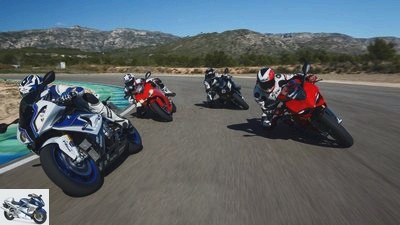
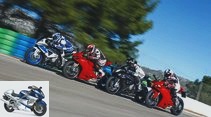
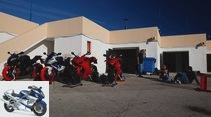
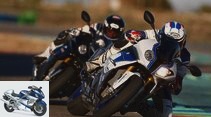
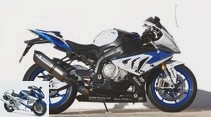
30th photos
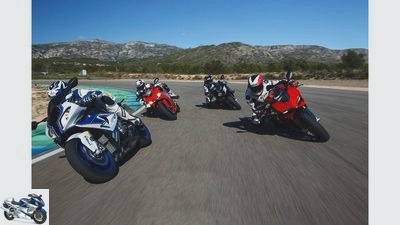
1/30
The top super athletes from BMW (HP4 and S 1000 RR) and Ducati (1199 Panigale / S) in the large MOTORRAD group test.
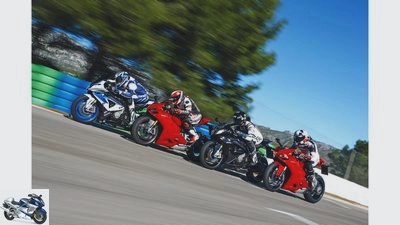
2/30
BMW HP4, Ducati 1199 Panigale S, BMW S 1000 RR and Ducati 1199 Panigale.
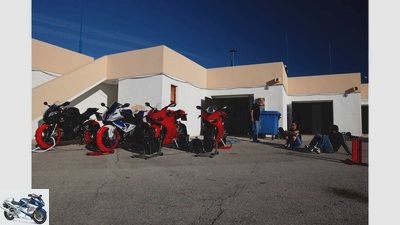
3/30
The calm before the storm: sun, no wind and the electric blankets bring the tires up to temperature.

4/30
BMW S 1000 RR and HP4.
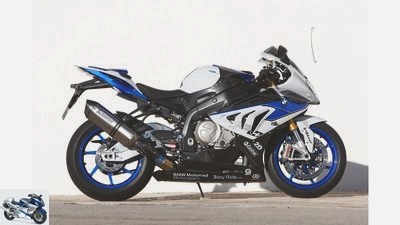
5/30
BMW HP4.
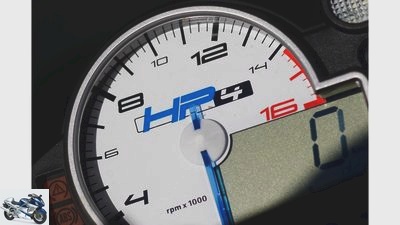
6/30
So that it matches the color: blue-colored needle on the HP4 tachometer.
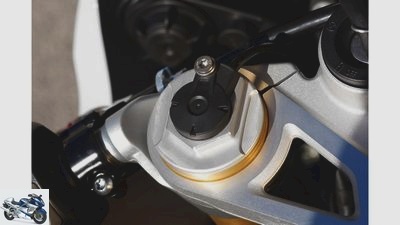
7/30
Neatly laid, protected against kinking: cable for the DDC in the left stile.
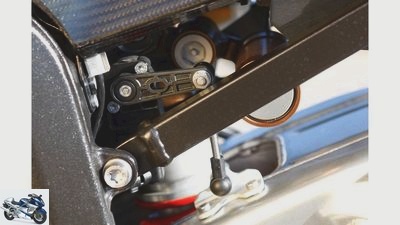
8/30
Spring travel sensor on the swing arm, spring base is adjusted hydraulically.
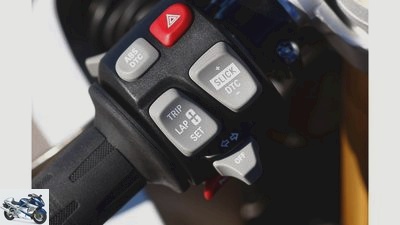
9/30
Additional rocker switch for fine adjustment of the DTC in slick mode.
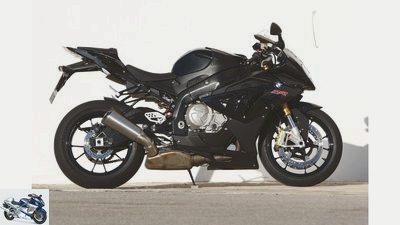
10/30
BMW S 1000 RR.
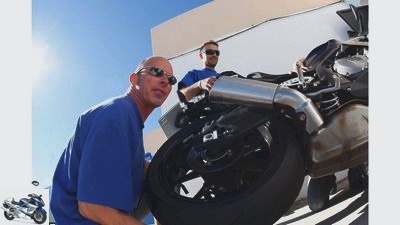
11/30
With two helpers, the rear of the S 1000 RR can be quickly raised using the variable upper strut mount.
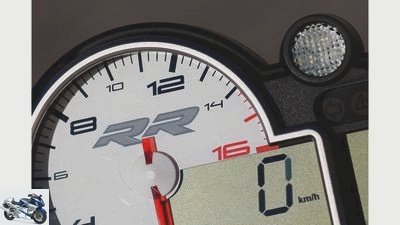
12/30
The S 1000 RR also has the clearly recognizable shift light.
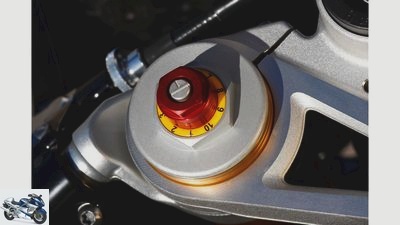
13/30
Preload, tension and compression can be adjusted on both bars.
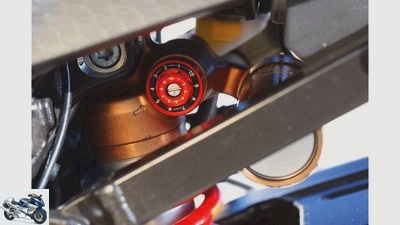
14/30
Simple, clear setting of the pressure level in high and low speed.
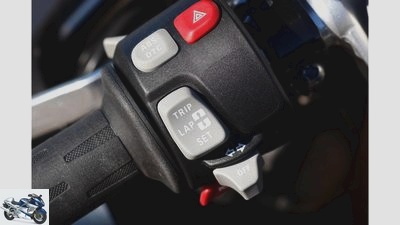
15/30
The S 1000 RR sets the standard in terms of usability of the electronics.
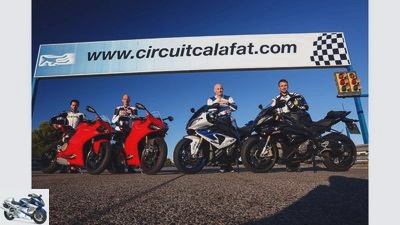
16/30
Ducati 1199 Panigale / S and BMW HP4 / S 1000 RR.

17/30
Better safe than sorry. Oscar, a race-tested colleague from the Spanish sister paper “Motociclismo”, during the final air pressure check.
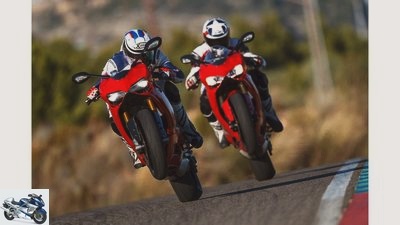
18/30
Ducati 1199 Panigale / S.
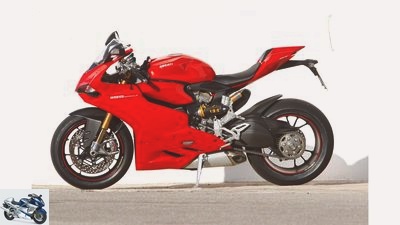
19/30
Ducati 1199 Panigale S..
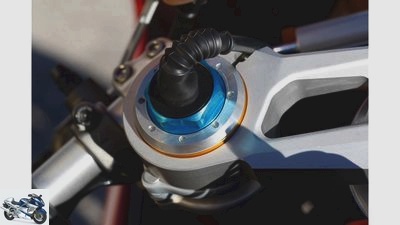
20/30
Ducati 1199 Panigale S: To change the spring preload, first remove the plug for the damper valves.
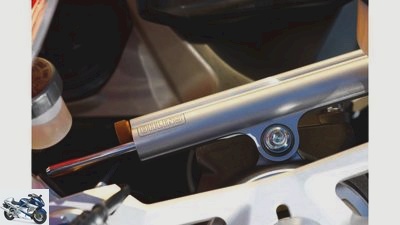
21/30
Ducati 1199 Panigale S: The adjustable Ohlins steering damper opens up more possibilities.
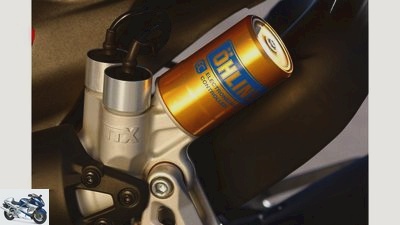
22/30
Ducati 1199 Panigale S: Although exposed, the cables of the TTX shock absorber do not interfere in any way when driving.
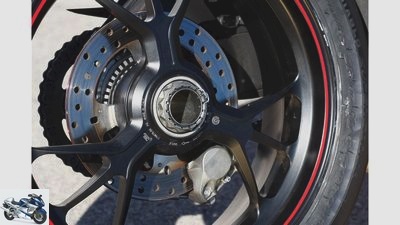
23/30
Ducati 1199 Panigale S: These forged wheels are so light that hardly any accessory wheels are needed.
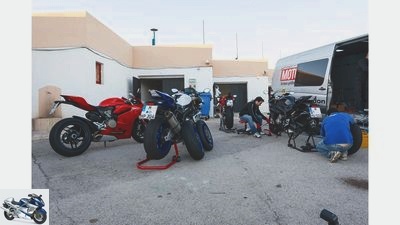
24/30
Where wood is chopped, splinters must fall. After a tough day on the track, the rear tires were worn out.
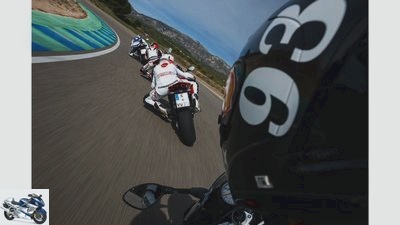
25/30
The grip of the street legal Pirelli Supercorsa SP is unbelievable.
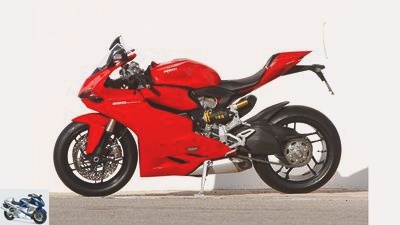
26/30
Ducati 1199 Panigale.
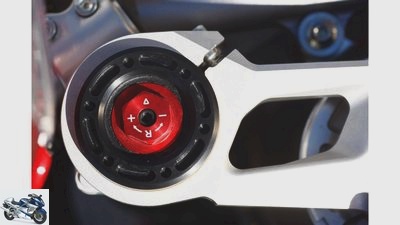
27/30
Ducati 1199 Panigale: The Marzocchi fork has sliding tubes with a diameter of 50 mm.
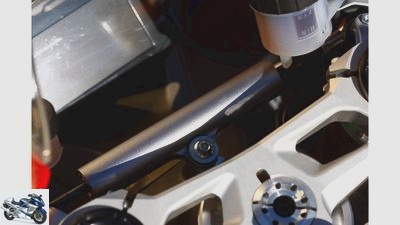
28/30
Ducati 1199 Panigale: The non-adjustable steering damper is sufficient for most matters.
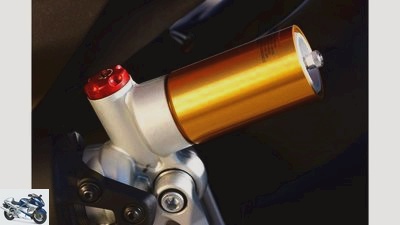
29/30
Ducati 1199 Panigale: The conventional shock absorber made a good impression on the racetrack.
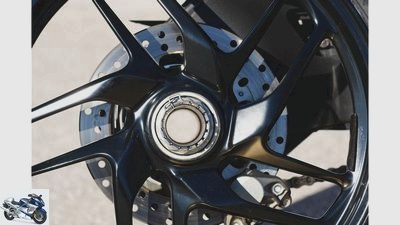
30/30
Ducati 1199 Panigale: Although “only” cast wheels, the Panigale rims already save considerable weight.
Test: BMW S 1000 RR against HP4 and Ducati 1199 Panigale against Panigale S.
Race track comparison: BMW and Ducati super sports cars
Quarrel happens in the best families. Especially when the offspring were given different dowries. But the BMW HP4 with partially active chassis and Ducati Panigale S with electronically adjustable Ohlins chassis are actually ahead of their cheaper basic versions?
Where is all this going? This question was passionately discussed when BMW set out to tear down the 200-horsepower wall with the S 1000 RR, and Kawasaki followed suit with the ZX-10R.
It is now clear: not in the direction of even more performance. At least not for the time being. The arms race has shifted to another area: electronics. After traction, wheelie and start controls, it is now the turn of the chassis.
In the HP4, the electronics monitor the activities of the spring elements for the first time, react to road and road conditions and intervene in the damping system if necessary. The first partially active chassis in series production. A novelty.
Ducati doesn’t go that far with the Panigale S. With the Italo-Sportler, however, you can at least choose your own setup from the handlebars via an operating menu in addition to three pre-configured chassis settings. As with the BMW, the dampers are then adjusted using electromagnetic valves.
First of all, this is very convenient. And not cheap. In the case of the HP4 (without competition package), the surcharge for the S 1000 RR with ABS, traction control and automatic gearshift, which are standard on the HP4, is 2800 euros. To the Ducati Panigale with a "S." to ennoble, even 5000 euros more have to wander over the counter.
A.What are the benefits compared to the much cheaper basic models with standard chassis? That can only be played on the racetrack. On the penultimate groove, when filing by the last tenth. After all, BMW sees the determination of the HP4 mainly on the race track. And the home of the Ducatis has always been the circuit.
Buy complete article
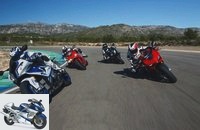
Test: BMW S 1000 RR against HP4 and Ducati 1199 Panigale against Panigale S.
Race track comparison: BMW and Ducati super sports cars
Ducati 1199 Panigale / S and BMW HP4 / S 1000 RR.
And the voting rounds quickly reveal something else: When it comes to handling, the S 1000 RR has little grace to expect from its high-performance sister. This is why the rear of the RR was raised a bit by means of the variable upper strut mount.
And everything in the Ducati house? How you take it. The testers unanimously tackled the tough hindquarters of the Panigale S with less pressure. At the fork, on the other hand, it can be a little more for the hard brake corners. Above all, however, it is becoming apparent that the standard Panigale will not be so easily satisfied with being in the second tier.
Maybe not quite as crisp, but pleasant, a little softer and almost more harmonious than that "S.", note the testers in the rubric "landing gear" after the first day. Well that can be exciting tomorrow.
Before that, however, there is a new set of rubbers. The testers swap the throttle grip for a mounting lever and torque wrench. As the sun sets, all four machines roll into the box with fresh tires and refueled. end of working day.
The next day’s conditions are perfect. No wind, the Spanish autumn sun warms you as much as you can, and the electric blankets have been roaring for an hour. One last check of the air pressure, then you can start. The beginning belongs to the BMWs. Christian grabs the S 1000 RR and rolls out. Knead the tires for one lap, then there is fire.
The power of the four-cylinder is gigantic, its revving power incredible. Second and third gear are sufficient for large parts of the route. Only the home straight offers the opportunity to tick in the fourth, or even the fifth, before it goes into the iron at 261 km / h and with a full slope over a small hilltop to brake on a tight right bend.
Effective traction control is then required, because a full shower goes out onto the following short straight in a right-hand leaning position.
But turning into the home straight is also tough. Second gear, throttle valve on stop, the load is thrown around from right to left, shifted up to third gear and fully charged. Just at the point where a depression lurks in the asphalt. The S 1000 RR pumps a little with the hindquarters, but masters the passage without the rider’s heart palpitations.
The gear changes sit perfectly and are a pleasure thanks to the fine automatic gearshift. However, after four or five laps, the pressure point of the brakes kneels down and moves significantly towards the handlebars. Nevertheless, the stopwatch reports 1: 32.00 min. A top time, and that with road tires. But what it is worth will soon be seen. The heating blankets are unrolled from the HP4. Now it’s getting exciting.
Kelle cannot be asked for long. After four rounds, the result is in the box. Startled eyes stare at the stopwatches. The HP4 did not take any prisoners. 1: 30.9 min. Kelle rolls back into the paddock and grins. Of course, thanks to the slightly more powerful torque, the HP4 pushes forward more emphatically from the tight corners. But in top performance they don’t give each other anything.
The calm before the storm: sun, no wind and the electric blankets bring the tires up to temperature.
Where she then makes up for over a second? "A huge difference to the RR", Christian puffs. "Holding the line at the exit of the corner is much easier." In addition, the chassis is much tighter and quieter, more direct. She masters that wave at the beginning of the home straight with a lot more calm. The quick turning in the chicanes does not cause any unrest in the chassis. No matter what, the semi-active chassis always seems to have the right answer on the demanding course.
But that’s not all. The weight advantage and, above all, the lighter wheels – they alone save 2.1 kilograms of unsprung weight – help the HP4 to handle significantly more nimbly. Especially in the rear section of the track, which is full of chicanes, the S 1000 RR has to give up. The HP4 is more precise when turning, it keeps the tight line more consistently. In addition, the traction control of the RR slows down the forward thrust at the exit of the curve for merciless tweaking of the tenths a bit more than that of the HP4. In slick mode, the desired slip can be fine-tuned using a switch on the handlebar. Until you sprint out of the curves with gentle slides and maximum propulsion. Advantage HP4. Or in numbers: At the braking point at the end of the home straight, there are 266 km / h.
And then there is the brake. The Brembo monoblocks of the HP4 cannot be scaled down, grabbing lap after lap with monumental force. That the pressure point might be a bit crisper – free. On the other hand, their Race ABS is first-class, sharply tuned, and its intervention is hardly noticeable. Anyone who claims that it is hindering their time chasing should apply as quickly as possible for Melandri’s place. But electronic helpers and the impressive lap times should not hide the fact that it is a mighty exhausting affair to drive against the clock with this rocket, with its sheer force. There is no time to breathe, the curves just come by. Full concentration is required every second. That goes for both. In any case, the family hierarchy is clearly clarified.
And who sets the tone at Ducati? The Panigale warms up with an iron bark. Madness, this twin tube, when Christian Kellner turns into the home straight with her for the first time.
How does she get out of the affair compared to the nobler sister S? And almost even more burning: What can she do against the BMWs? Even if compared to the siren-like howling of the high-revving BMW four-cylinder, the low-frequency roar of the Ducati almost sounds as if Christian was burning across the home straight with braked foam. But the way he lets the Panigale fly into the first corner, there is no doubt: it applies.
The seating position on the Duc is much more racing compared to the BMW. Closer to the handlebars, intimate contact with the front wheel, narrow tank. Firmer seat pad. And the flared handlebar stubs fit just as better as the more open knee angle. A seating position that is made for aggressively stabbing into corners.
Great, how the twin powers up from the corners. At over 8000 rpm he grabs so vehemently that the Ducati is in no time at all on the rear wheel. In the case of the HP4, the wheelie control gently brings the front wheel back down to earth, while the Ducati demands more of the throttle. Or the shift foot. As soon as the front wheel rises, simply let the accelerator stand still, press the next gear using the automatic gearshift and the twin’s brilliant revving will do the rest on the way to the next bend.
The grip of the street legal Pirelli Supercorsa SP is unbelievable.
The fact that the Panigale with its shorter geared gears requires a little more gearshift work is not a handicap, at least here. On the contrary. Because the Duc, unlike the BMW, often rushes one gear higher and therefore not at full speed and the associated power explosion in the braking zones.
Only at the end of the home straight does she have to bow to the BMWs when it comes to top speed with 257 km / h. But as I said at the beginning, performance is not everything in Calafat, the chassis plays an important role.
How the Ducati, supported by the compact, front-wheel-oriented seating position, digs into corners and dashes through chicanes, is a stunner. The fact that the Panigale folds inwards a little at the top of the curve when the brake is released is noticeable, but not really annoying. Kelle even accommodates it. And that they get the predicate when they are turned down quickly "Lies like concrete" just missed is not a drama either.
The fact that there is some movement in the chassis does not detract from the otherwise great stability. Because the Panigale looks well balanced. And not only is it a pleasure to turn sharply, but also to cock the tap at the exit of the curve. Because the traction control keeps watch over the rear wheel. With one caveat, however. Accelerated over an eroded point in the asphalt surface at the exit of the first right-hand bend, the Ducati’s slip control reduces the power noticeably longer than that of the BMW, which immediately provides full power again. And yet it undercuts the time of the S 1000 RR with 1: 31.5 minutes. Is it ultimately also the faster Panigale? The bar is set pretty high for the Panigale S. On the other hand, the forged wheels and electronically adjustable Ohlins spring elements can throw in the balance. The rest of the electronics from ABS to traction control, however, are identical.
So what can she do "S." tear? Kelle turns round after round, subjugates the Duc through the chicanes, squeezes it out on the home straight. The top speed at the braking point is identical to that of the Panigale; neither can the BMW. Oh dear, can this still be something? The eyes are fixed on the stopwatch. It finally stops at 1: 31.0 min. The hammer. Not only would the family pecking order be restored. It also pulls up to a tenth of the same as the HP4. But both reach their times in completely different ways. While the HP4 mainly makes up its time on the power sections and is clearly ahead at top speed, the Ducati strikes in the curvy sections. Like the BMW HP4, the Panigale S benefits from its lighter wheels. The way she crashes through the harassment is a force.
Their forged wheels are sensationally light at 3.1 kg (front) and 3.7 kg for standard bikes. Compared to the cast counterparts of the Panigale, they save 2.8 kg. But the difference in handling is not nearly as big as between the BMWs. The significantly tighter chassis gives the Panigale S a little more crisp directness. At medium speed it still looks hard and stiff. But the higher the speed, the better it works. In contrast, the BMW HP4 with its partially active chassis was equally stable at every speed.
Remarkable: The pumping on the Ducati hindquarters, which was still criticized in the large athlete comparison in Alcarras (MOTORRAD 10/2012), did not occur in any of the Ducs, and the tire wear remained within the limits with their high-tech chassis, they are ahead of their more simply equipped basic models. Sometimes more (BMW), sometimes less (Ducati) significantly. The surcharges for it, however, are sometimes more (Ducati), sometimes less (BMW) juicy.
In the end, there would only be one question left: where are the Japanese?
Ducati 1199 Panigale / S.
Ducati 1199 Panigale / S
The Panigale S is the faster of the two red ones, a crucial bit more stable and agile, but also a whopping 5000 euros more expensive. The fact that there is almost nothing outwardly indicating the noble variant is understated. A case for lovers of something special. Because the gap to the base Panigale is not very big. It is a real surprise in this exciting comparison, pleases with its balance and is only a little slower than its classy sister. Those who do without shiny golden spring elements and can live with the handle of the Allen key for setup changes are well served with it. And for the money you save, you can afford some racing training – and maybe a set of lightweight bikes.
BMW S 1000 RR and HP4.
BMW HP4 / S 1000 RR
It is no coincidence that the S 1000 RR has so far left its mark on this class. She is a strong piece. Your engine is still a stunner. But the HP4 is clearly the better one. Superior in handling, more confident in braking. It is more precise, more powerful. And the semi-active chassis is impressive. Just like the redesigned electronic helpers. A mighty caliber not only on the racetrack. There the gap to the S 1000 RR is clear and also much clearer than it is between the two Ducatis. BMW has landed another big hit with the HP4, which the competition should have to nibble on. No question about it, it is definitely worth the purchase of an S 1000 RR.
Technology: chassis
Ducati: The factory-set damper settings – here the race mode – can be adapted to your own needs via a menu.
The possibilities of electronics seem unlimited. Now it has also found its way into the chassis.
Up to now, the term electronic chassis has been used to refer to electronically adjustable spring elements, but this term must now be specified. Because the HP4 offers much more than that, namely a partially active, i.e. electronically controlled chassis. As the name Dynamic Damping Control (DDC) suggests, the chassis reacts to different road and driving conditions. It also offers three preset damping modes (Road, Dynamic, Track), but the damping can still be changed individually. The electronic damper valves can change the damping within a hundredth of a second. A sensor on the rocker detects the compression and rebound movement and speed. In conjunction with other parameters such as speed, throttle position, lean angle, brake pressure, traction control and acceleration, the control unit calculates to what extent the rebound or compression stage on the shock absorber needs to be changed. At the same time, the damping is adjusted in the fork, which does not require a travel sensor.
Lap times and setup
archive
The technically demanding 3.25 km long route south of Tarragona has existed for almost 40 years. The legendary Masterbike was held there for the first time in 1998. Back then the Kawasaki ZX-9R dominated.
What the stopwatch keeps track of is one thing. Much more interesting, however, is how this time comes about.
Full 14 hp more, 8 km / h faster at the end of the home straight and just a tenth ahead? HP4 and Panigale S not only represent completely different concepts, they also get their time in completely different ways, as 2D recording shows. The time loss curve proves that the HP4 gains time from the start of the home straight and builds on this lead, especially on the straight up to the measuring point of Vmax2.
archive
The green time loss curve shows that the HP4 is starting to build a lead over the Panigale S on the home straight. The Duc nibbles a little in every corner, and from the middle of the lap she completely catches up again.
But then the curvy part (gray) follows, and the Panigale S takes back a tenth of a tenth in the curves with terrific handiness and stability. More speed at the corner entrance and at the top of the corner, until there is practically a tie again at the finish line. Compared to the S 1000 RR, the HP4 is able to convert its significantly better handiness and the more stable, more precise chassis into a lead, especially in the curvy part of the route highlighted in gray. The more finely regulated traction control also ensures a higher top speed.
| BMW HP4 | BMW S 1000 RR | Ducati 1199 Panigale S. | Ducati 1199 Panigale | |
| Lap time (min) * | 1: 30.9 min | 1: 32.0 min | 1: 31.0 min | 1: 31.5 min | Vmax1 | 266 | 261 | 258 | 257 |
| Vmax2 | 205 | 201 | 202 | 201 | Fork* |
| Pressure level | Track (slick) | Item 7 | Item 7 | 8 K | Rebound | Track (slick) | Item 6 | Item 14 | 7 K |
| Negative travel * | 30 mm | 35 mm | 39 mm | 34 mm | Shock absorber * |
| Low speed compression | Track (slick) | Item 9 | Item 20 | 11 K | High speed compression | Track (slick) | Item 5 | – | – |
| Rebound | – | Item 6 | Item 14 | 3 K | Negative travel * | 20 mm | 19 mm | 25 mm | 30 mm |
* with driver (75 kg); U = revolutions; K = clicks; R = rings; Pos. = Position
Technical specifications
BMW HP4, Ducati 1199 Panigale S, BMW S 1000 RR and Ducati 1199 Panigale.
| BMW HP4 / S 1000 RR | Ducati 1199 Panigale / S | engine |
| design type | Four-cylinder, four-stroke in-line engine | Two cylinder four stroke 90 degree V engine | injection | Ø 48 mm | Ø 68 mm |
| Bore x stroke | 80.0 x 49.7 mm | 112.0 x 60.8 mm | Displacement | 999 cm3 | 1198 cm3 |
| power | 142.0 kW (193 hp) at 13,000 rpm | 143.0 kW (195 hp) at 10750 rpm | Torque | 112 Nm at 9750 rpm | 132 Nm at 9000 rpm |
| landing gear | frame | Bridge frame made of aluminum | Aluminum monocoque |
| fork | Upside-down fork: Ø 46 mm | Upside-down fork: Ø 43 mm / Ø 50 mm | Brakes front / rear | Ø 320/220 mm: ABS | Ø 330/245 mm: ABS |
| bikes | Forged aluminum wheels / cast aluminum wheels | Forged aluminum wheels / cast aluminum wheels | Front tire | 120/70 ZR 17 | 120/70 ZR 17 |
| Rear tire | 200/55 ZR 17 / 190/55 ZR 17 | 200/55 ZR 17 | Tires | Pirelli Supercorsa SP | Pirelli Supercorsa SP |
| Dimensions + weights | wheelbase | 1423 mm | 1437 mm |
| Steering head angle | 66.0 degrees | 65.5 degrees | trailing | 99 mm | 100 mm |
| Weight with full tank ** | 201 kg / 209 kg | 193 kg / 195 kg | Tank capacity | 17.5 liters | 17.0 liters |
| Service intervals | 10000 km | 12,000 km | price | 20,500 euros / 16,100 euros | 24,490 euros / 19,490 euros |
| Price test motorcycle | 24750 euros *** / 17894 euros **** | 24,490 euros / 19,490 euros | Additional costs | 269 euros | 305 euros |
| MOTORCYCLE readings | Top speed * | 299 km / h | 296 km / h |
| acceleration | 0-100 km / h | 3.2 sec | 3.2 sec |
| 0-200 km / h | 7.2 sec | 7.6 sec |
* Manufacturer information; ** MOTORCYCLE measurements; ***Incl. Competition package (3200 euros), consisting of footrest system, hand lever, carbon kit, forged wheels in vehicle color and sponsor sticker set; Passenger package (260 euros), heated grips (200 euros) and data logger (590 euros); ****Incl. ABS and DTC (1230 euros), automatic gearshift (364 euros) and heated grips (200 euros)
archive
Power on the crankshaft. Measurements on the Dynojet roller test stand 250, corrected according to 95/1 / EG, maximum possible deviation ± 5%.
Both Ducatis paint practically identical performance curves on paper. The BMW HP4, on the other hand, shows itself to be significantly more powerful than the S 1000 RR in terms of torque in the medium engine speed range, without sacrificing top performance. On the contrary, it was even a tad better in the feed. To the extent that the Ducatis miss the factory specification, the BMWs are above it. The performance of the Bavarian women from 11,000 rpm is spectacular, while the torque of the Ducatis is impressive.
Related articles
-
Comparison test BMW S 1000 RR, Ducati 1299 Panigale S and Yamaha YZF-R1
fact 46 pictures fact 1/46 Yamaha YZF-R1. fact 2/46 BMW S 1000 RR. fact 3/46 The swing arm takes the wheel axle very far back – good for the …
-
Ducati 1199 Panigale S already driven
Manufacturer 15 pictures 1/15 Grim look: LED headlights are being used for the first time in a motorcycle. 2/15 Ducati 1199 …
-
Ducati Panigale R and Yamaha YZF-R1M in the track test
24 pictures www. 1/24 Two completely different engine concepts are put to the comparison test. www. 2/24 The tank …
-
Ducati 959 Panigale, Husqvarna 701 Supermoto, Kawasaki Z 1000 SX, Triumph Speed Triple R.
factstudio.de 24 pictures factstudio.de 1/24 Ducati 959 Panigale factstudio.de 2/24 Husqvarna 701 SM, Triumph Speed Triple R, Ducati 959 Panigale, Kawasaki …
-
7th place: Ducati 1199 Panigale
Photo: 10 photos 1/10 Dream bike choice, 7th place: Ducati 1199 Panigale 2/10 Dream bike choice, 7th place: Ducati…
-
Ducati 1199 Panigale, KTM 1290 Super Adventure, Suzuki Hayabusa and Yamaha YZF-R3
fact 25 pictures fact 1/25 From south to north, as fast as possible, with different combatants, a lot of collected data, pain and the …
-
Comparison test Aprilia RSV4 R APRC and Ducati 1199 Panigale
fact comparison test: Aprilia RSV4 R APRC and Ducati 1199 Panigale The best Italian superbikes in comparison The more expensive versions first – few …
-
Ducati 1199 Panigale S in the top test
15 pictures 1/15 Grim look: LED headlights are being used for the first time in a motorcycle. 2/15 Ducati 1199 …
-
Generation comparison Ducati 1299 Panigale R Final Edition 2017 and Ducati 1199 Panigale from 2012
markus-jahn.de 27 pictures markus-jahn.de 1/27 Generation comparison: 1199 Panigale vs. 1299 Panigale R Final Edition. markus-jahn.de 2/27 …
-
Ducati 959 Panigale and MV Agusta F3 800 RC in comparison test
28 pictures 1/28 The two beautiful Italian racers Ducati 959 Panigale and MV Agusta F3 800 RC in a comparison test ….